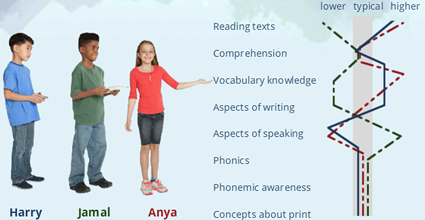The NSW Literacy continuum K-10 is used in DoE schools in different ways for a variety of purposes.
The following are examples of programs and packages which are informed by the literacy continuum.
Whole school literacy planning

The Literacy matrix assists school leaders to determine the level of professional knowledge in literacy and literacy practice across the school. It allows for the plotting of use and understanding of the NSW Literacy continuum K-10, and suggests pathways for professional learning.
You can access the Literacy matrix on the NSW DoE literacy support website1.
Guidance with whole school planning using the NSW Literacy continuum K-10 is available at Getting started with the Literacy continuum K-102.
Tracking student progress

PLAN software3 K-10 supports teachers to record, analyse and monitor student progress through the Literacy and Numeracy continuums K-10.
The software is informed by the teaching and learning cycle, the Quality teaching in NSW document and the literacy and numeracy continuums K-10. Visit the support page for the continuums (requires DoE log in).
Download the Quality teaching in NSW document from Quality Teaching Resources4.
Professional learning programs, networks and initiatives

The Best Start Kindergarten assessment5 is a matching of each child’s skills in literacy and numeracy on entry to school. All Kindergarten students in DoE schools are assessed against the Literacy and Numeracy continuum markers.
This assessment provides guidance for teachers, and a starting point for each student’s literacy learning at school. Progress is then mapped using the PLAN software.

Language, Learning and Literacy - L3 Kindergarten (L3K)6 is a whole-stage Kindergarten intervention that supports the teachers of students who are at risk of not achieving expected literacy levels by the end of their first year of schooling.
Language, Learning and Literacy - L3 Stage 17 is a whole stage quality teaching initiative that aims to build on students' literacy learning from Language, Learning and Literacy (L3K) in Kindergarten.

New Focus on Reading8 3-6 is a literacy professional learning package for classroom teachers. It builds teachers' knowledge and strategies for the explicit teaching of reading and vocabulary in Stages 2 and 3, and can be extended to Stage 4. It focuses on the skills and strategies students require in order to access the increasingly complex texts they encounter in all subjects in the middle years.


Different paths of progress
The information below is important for the Course deliverable.
Students progress differently through the literacy continuum. Teachers design lessons which address literacy at the point of need and assist the students to work towards the next cluster.
Jamal, Harry and Anya have different skills in reading texts at the end of stage 3. The teacher identifies the need to focus on differentiating learning activities for each student.
During a research lesson in the library the students will work from a selection that includes both short and long texts, visuals, and multi-modal texts, all with context specific vocabulary.
-
Jamal will work with a partner to generate questions about the text content. This will allow him to use his speaking and comprehension skills to further develop his reading.
-
Harry is a little more independent so he will access a visual and a print text and compare the content.
-
Anya will work with an audio-visual text to create a short summary. She then selects a print text to build upon her content knowledge.

The teacher could decide to focus on the first marker of the reading aspects for clusters 10, 11 and 12, which addresses reading more and longer texts for more sustained periods of time.
|
|
In this activity, we’ll examine three significant strategies for reading texts and the literacy demands of two examples. Complete Activity 6 in your Activity booklet. |
|
|
Create and trial a teaching idea that demonstrates an understanding of the literacy demands of one subject. Include reference to the NSW Literacy continuum K-10. The teaching idea may be:
|
Links
- https://detwww.det.nsw.edu.au/literacy-and-numeracy-support/literacy/resources
- https://detwww.det.nsw.edu.au/literacy-and-numeracy-support/literacy/getting-started
- https://detwww.det.nsw.edu.au/primary-education/plan-software
- https://detwww.det.nsw.edu.au/publicschoolsnsw/managing-and-supporting-staff/quality-teaching-resources
- https://detwww.det.nsw.edu.au/primary-education/literacy-and-numeracy/best-start-kindergarten-assessment
- https://detwww.det.nsw.edu.au/primary-education/literacy-and-numeracy/l3-language-learning-and-literacy
- https://detwww.det.nsw.edu.au/primary-education/plan-software/l3-stage-1
- https://detwww.det.nsw.edu.au/primary-education/literacy-and-numeracy/new-focus-on-reading


